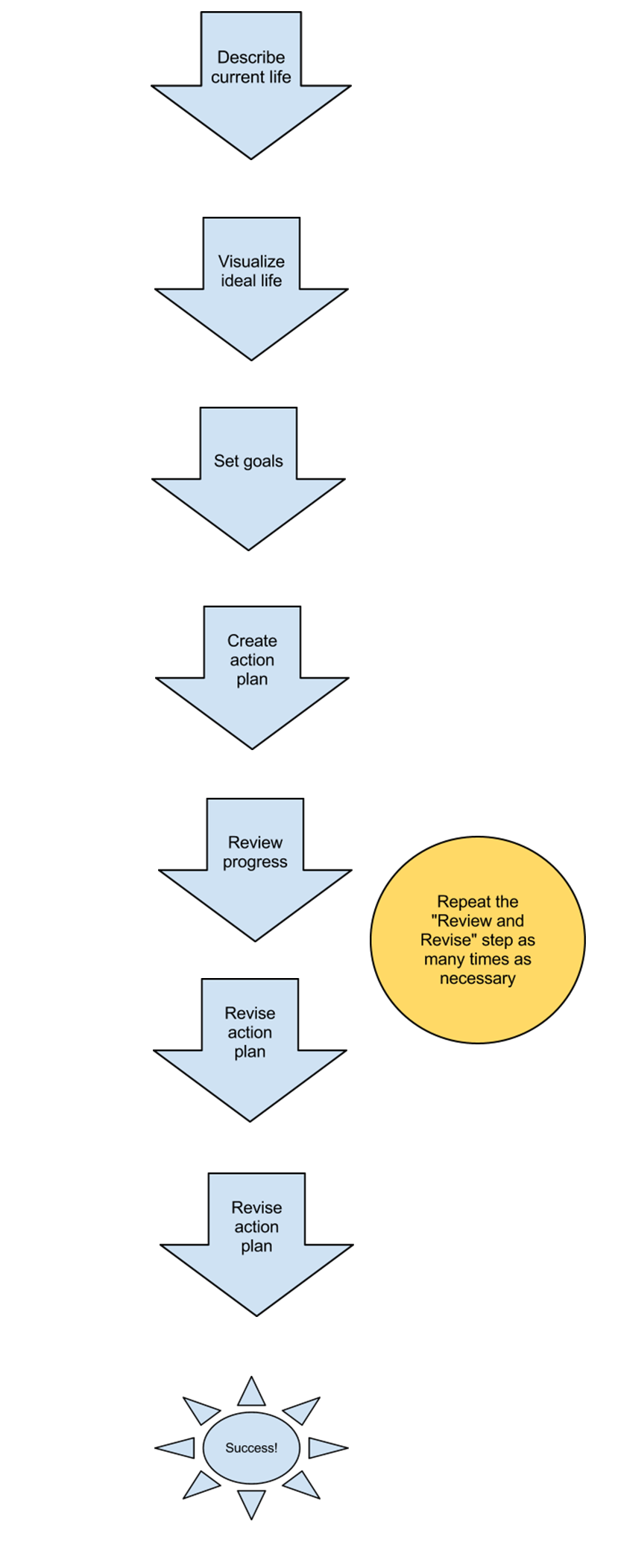A Coaching Model Created by Lauren Young
(Career Coach, UNITED STATES)
The purpose of this model is to provide clients with a clear and straightforward plan that is designed to get results.
 1) Learn current situation
1) Learn current situation
Far too many people berate themselves for not having achieved their goals by a set deadline. One of the things I tell all my clients is “You have to start from where you are.” In order to do that, I first ask the client to describe their current circumstances. I like to know about all the big areas of their life even if they’re not seeking life coaching. Knowing about these other areas of their life allows me to have a greater understanding of the client and how their goals fit in with their current lifestyle and values.
Part of learning about the client is to learn about their values. Many people are not fully aware of what their values are and thus they live a life that’s not in accord with their core values. By identifying their core values, clients can make decisions based on those values. When making goals, it’s important to know what your values are so that you can make sure that those goals fir your values. They don’t, it’s less likely that you’ll achieve those goals and be happy with your achievement.
2) Visualize the ideal outcome
While it’s fine to gain an understanding of the client’s current situation, it’s even more important to start moving them forward. To start that process, I ask them complete a visualization exercise wherein they imagine their ideal lives. I ask them to open their minds to all possibilities. I want them to write down things that may seem crazy at the time. I ask for a complete ideal life vision even if they’re only seeking coaching in one area of their life because they don’t live life one aspect at a time. What they do in one area will affect other areas.
I firmly believe the adage “You have to see it to believe it.” I take it a step further by saying “You have to see it to believe it and you have to believe it to be it.” That means that having the client visualize their ideal is the first step in their journey to realizing that life.
3) Identify the goal
Now that the client has a vision of their ideal life in their minds, it’s time to get down to the nitty gritty. It’s time to identify the goals that will get them that life. By looking at their ideal life, they can figure out what their goals are. The ideal life vision provides a snapshot of the end. Goal setting will help them get there. For instance if, in their ideal life vision, they envision themselves making partner at their law firm, they can set billable hours and networking goals. For each area on which they would like to be coach, there will be one or two major goals.
Now that we have a destination, it’s time to create the map.
4) Create an action plan
For each goal, the client will decide on required actions, deadlines and milestones. While I will guide the process and provide focus, the client will do the heavy lifting. This will give them ownership of their goals and the action plan.
In order to make the action plan seem more “real“, I will ask them to complete a written action plan. This written document will provide them with a roadmap to reaching their goals. The action plan will have them set specific and measureable goals and deadlines. There are spaces for weekly, monthly and quarterly deadlines. Having a written, detailed action plan will help the client make daily to-do list that will lead to them reaching their goals.
5) Review progress
At the beginning of each session, the client and I will review the past week’s goals and the client’s progress. It is during this time that we analyze the client’s progress and how it matches up with their goals. It is also a time to spend to see if the goals that they set still fit in with their values and ideal life vision.
6) Revise plan
After reviewing the client’s progress, the client and I will adjust the action plan as necessary. The adjustment could involve changing deadlines, changing or adding goals and reviewing values and making adjustments based on that. Once the adjustment is made, the written action plan is edited to reflect the changes.
7) Review progress and adjust plan, in needed
The “Review and Adjust” will continue until the client has reached their goals. As deadlines approach, it’s important to check in with the client to see how they feel about the goals. One of the things that’s important to impart on the client is the importance of being flexible in their approach to reaching their goals. While their goals may not change, the methods used to accomplish those goals likely will.
8) Success!!!!!!
The client has reached their goal! It’s time for celebration and reflection! What worked? What didn’t? How can they apply these lessons to future endeavors? These are all questions that I ask my clients. It’s my hope that they will be able to take what they’ve learned about themselves and apply them to future goals and as a reminder that they can reach their goals if they have faith in themselves and are willing to work hard and smart.